E-commerce marketing is a particularly critical task: unlike a brick-and-mortar store, an online store does not attract random passersby enticed by a shop window. Therefore, the success of an e-commerce is determined by the effectiveness of marketing efforts.
Fortunately for online merchants, digital marketing offers numerous different methods for acquiring customer traffic.
Let's explore successful e-commerce marketing in this article.
Google advertising offers easy wins
For many online stores, Google is the best choice as the first marketing channel. The reason is simple: a significant portion of people begins their buying journey through Google, making it possible to reach an audience already interested in the products the company sells.
The customer journey refers to the process that most customers go through before making a purchase decision. It starts with identifying a need. For example, a person may realize in the morning that their facial toner has run out. Assuming they have been dissatisfied with previous toner, they won't automatically repurchase the same product. Instead, they move to the next stage of the customer journey, which is information search.
Information search often begins through Google. The person might simply type "facial toner" into Google and explore the options that come up. After pressing enter, Google conducts a lightning-fast auction to determine which advertisers get their ads displayed for that particular search.
The facial toners found through ads seem appealing, prompting the person to compare their features. This leads them to the comparison stage, where they have identified a few interesting options and are making comparisons. In this stage, the person might use a search term like "facial toner reviews" to find information provided by other users about the product. After finding the best option, they make the purchase decision.
Through Google advertising, an online merchant showcases their products at the optimal stage of the customer journey – the information search stage. For this reason, it is the best channel for starting digital marketing for most businesses.
Search engine optimization perfectly complements Google advertising
Search engine optimization (SEO) is a method by which a company's website is elevated to the top of Google's organic search results. Organic search results are those for which no payments have been made to Google.
Google advertising yields quick results; ads start appearing on Google's search results page as soon as the campaign is active. On the other hand, SEO requires a more long-term strategy: reaching the first page of search results takes at least a few months (the timeline depends on the competitiveness of the keyword) and involves a significant amount of development efforts. Through Google advertising, a company can quickly gauge the potential of SEO, making it worthwhile to implement either before or concurrently with SEO.
An online store that incorporates SEO as a integral part of its digital marketing strategy can acquire substantial traffic by optimizing various content on its website. For instance, the online store can:
Optimize the product category for facial toners with the keyword "facial toner."
Optimize a more specific product page with the precise product name.
Use blog articles to optimize content related to various topics.
Content is one of the most crucial factors influencing search engine rankings, so the quantity and quality of text are critical aspects of SEO. It's advisable to write as much text as possible in product category and product page descriptions. In the category description, general information about products in that category can be provided, while the product page can delve into more specific details about the product, its benefits, and unique stories behind it.
The targeted keyword should appear at a density of 1-2 percent in the generated text. For example, in a 300-word description of a facial toner, the word "facial toner" should appear 3-6 times. With the advancement of artificial intelligence, Google has become adept at recognizing unnatural text, so it's not advisable to overstuff the text with keywords. However, the keyword still needs to be present in the right places and at the right density for Google to understand the content's topic.
In addition to category and product page descriptions, producing content through blog articles is beneficial. Blog articles are an excellent means of marketing for an online store as they can attract traffic that might be challenging to reach through other marketing methods. The key to successful articles is producing high-quality content that genuinely provides value to the reader, whether through inspiration or problem-solving.
How should an online store owner generate ideas for the company blog? By researching what people are searching for on Google! By typing "facial toner" into Google Ads' keyword planner, the following keywords emerge:
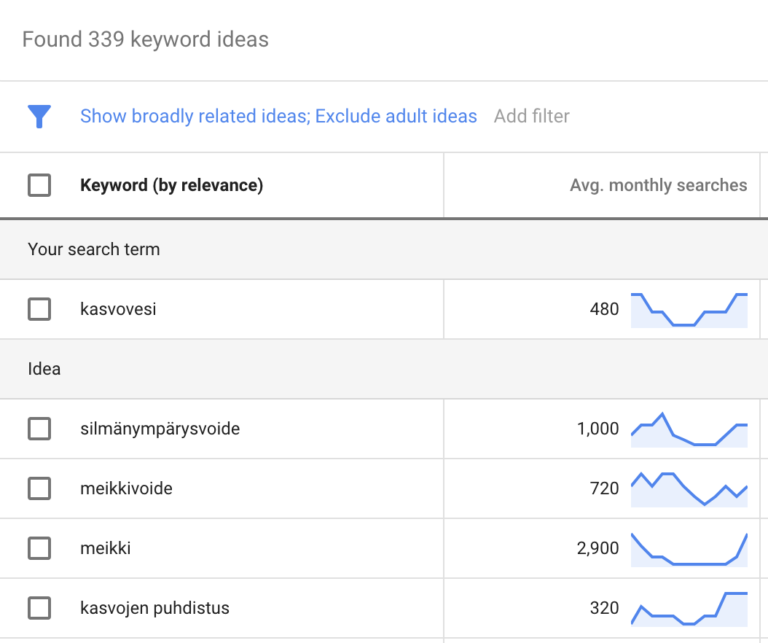
This is how you can immediately find plenty of good blog article ideas (to be precise, 339 ideas). Related keywords include:
facial cleansing
skin exfoliation
salicylic acid facial toner
facial care
Various inspiring or problem-solving articles could be written on these topics. Examples of such articles could be:
"5 Tips for Effective Facial Cleansing"
"Salicylic Acid Facial Toner Rescues Oily Skin"
People arriving through search engine optimization are in either the awareness or information-seeking stage of their customer journey. Direct product-related keywords (e.g., "best facial toner") bring traffic in the information-seeking stage, similar to Google Ads advertising, while keywords related to general information and inspiration (e.g., "facial cleansing") attract more traffic in the awareness stage.
Traffic coming through blog articles is also exposed to your company's brand, making it an excellent method for building awareness. According to various studies, a person needs to be exposed to a company's brand six times before they are ready to become a customer. By creating abundant high-quality and search engine-optimized content in the form of blog articles, you can naturally generate awareness for your online store through search engines.
One of the significant advantages of search engine optimization is its cost-effectiveness: once good search engine rankings are achieved, they bring in traffic month after month and year after year without any separate payments to Google.
Social media marketing provides visibility
Social media is a crucial aspect of online store marketing. In a 2018 study conducted by Social Media Examiner, 5700 marketers were interviewed. According to the study, the most popular social media marketing channels for retail are:
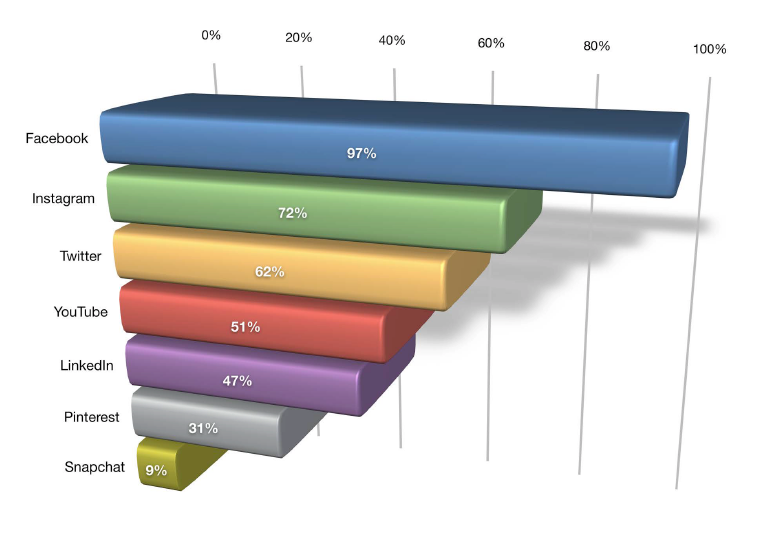
Facebook remains the clear favorite marketing channel, making it a good choice for most online stores as their first social media platform. However, before making a decision, businesses need to evaluate the demographic characteristics (age, gender, profession, etc.) of the chosen platform in relation to the products they sell. For instance, below is a graph of Instagram's user demographic:
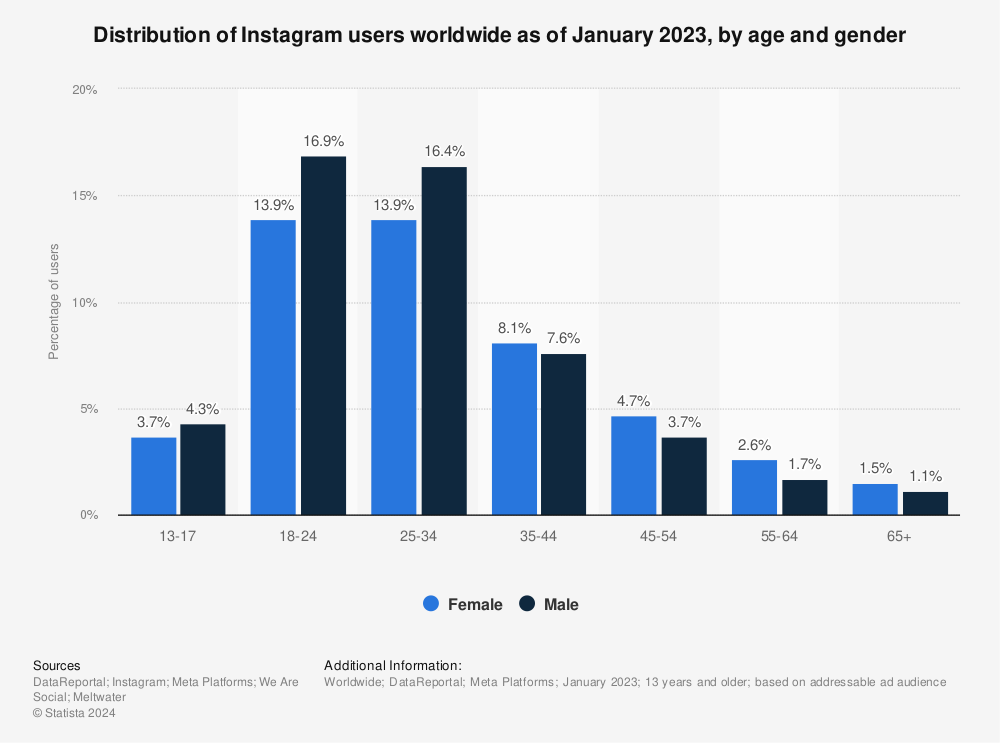
Therefore, an online store targeting young adults might consider taking over Instagram. Social media marketing encompasses both organic marketing (non-paid updates) and paid advertising, so the takeover can also be done through advertising if the company lacks resources for organic updates.
Especially on Facebook, the visibility of non-paid updates has decreased in recent years. To ensure sufficient visibility, paid advertising is recommended even if the company also engages in organic updates.
Paid advertising can, for example, enhance the visibility of organic updates. By promoting posts, you can identify updates that resonate particularly well with your target audience.

A metric to use is the engagement ratio, where engaged users are divided by the number of people the post reached. If a post reached 400 people and received 40 engagements, the engagement ratio is 40/400 = 10%. The higher the engagement, the better the post has performed. This way, you don't have to guess what your followers might want to see but can experiment to find the right approach for your updates.
Remember that for comparison, test conditions must be the same - meaning that posts should be targeted to the same audience.
In organic updates, avoid overly promoting your company's products. You probably wouldn't want to follow an account that constantly pushes its products, right? In social media, it's essential to strive to provide value by offering information and inspiring your followers.
For this reason, in addition to boosting updates, consider trying out 100 % advertisements. In advertisements, you can focus on showcasing the superior features and benefits of your products.
In the Social Media Examiner study, marketers were asked about the benefits they gained from social media.
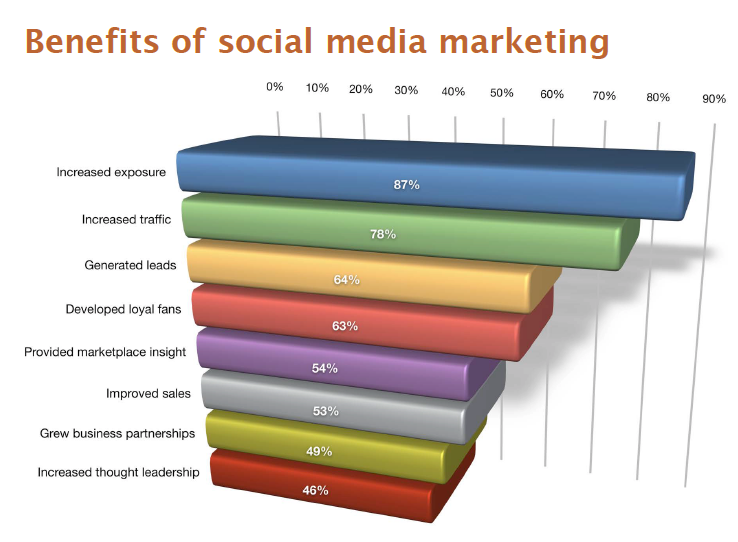
Increased visibility, traffic, and lead generation were the three most significant benefits that marketers attributed to their social media efforts.
Retargeting is particularly effective
For online stores, an unfortunate fact holds true: on average, only 1-2 percent of visitors to an online store convert, meaning they make a purchase. The majority of visitors, around 98-99 percent, leave the site without buying anything. The purpose of retargeting is to reach these visitors.
Retargeting is commonly done through the display network, Facebook, or email. To implement retargeting, the source code of the online store needs to be equipped with the necessary code snippets for the chosen advertising channel. These snippets enable the targeting of ads to individuals who have visited your company's website.
In Google Ads, retargeting can be done through Google's display network, which includes millions of different websites. Retargeting is carried out through image and/or video ads.
In Facebook and Instagram, retargeting operates in a similar fashion.
Through email, retargeting can be done, for example, to individuals who have added items to their shopping cart but closed the browser before completing the transaction. Naturally, the customer's email address must be known for this purpose.
Abandoning a shopping cart is not an uncommon occurrence: last year, nearly 70% of visitors abandoned their transactions!
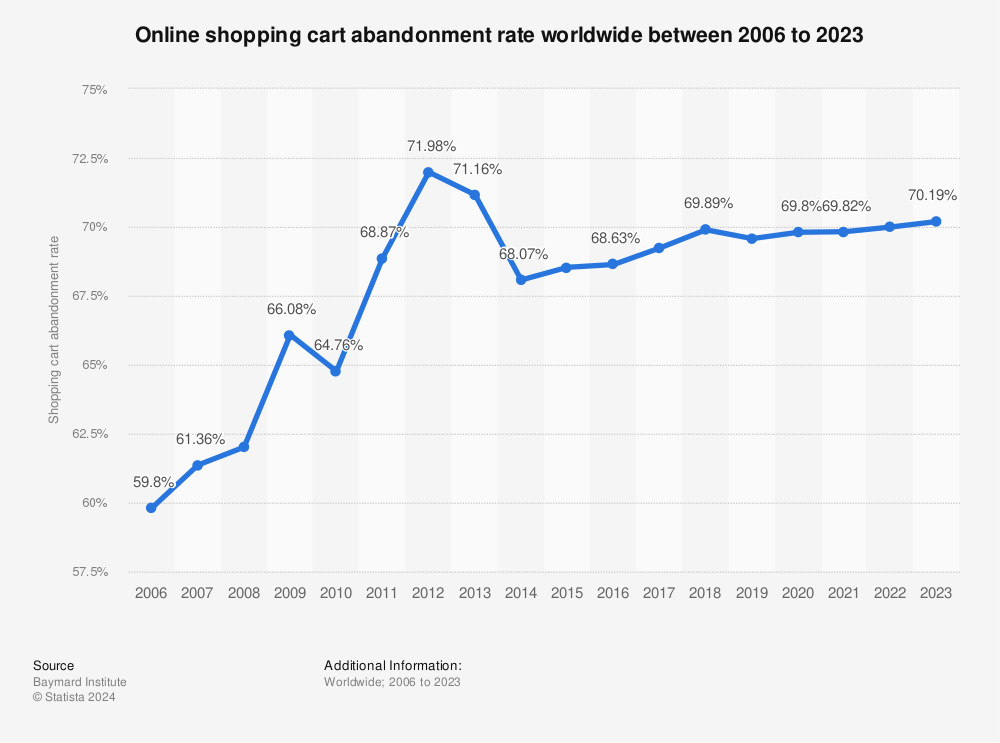
For demonstration purposes, I added a product to my Amazon shopping cart and closed the browser. Shortly afterward, I received the following message:
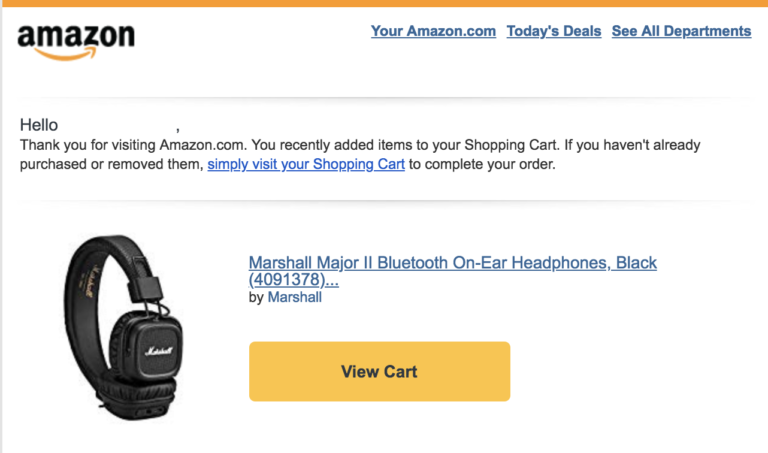
I could continue the interrupted transaction by clicking the button in the email. The ease of continuing the process is particularly important – the visitor already abandoned their shopping cart once, so they are unlikely to complete the purchase if the process feels even slightly complicated.
Amazon, being a major player in the e-commerce business, understands the industry well. Emulating their marketing techniques is a solid strategy.
Collecting email lists is well-suited for ecommerce marketing
As discussed in the previous paragraph, retargeting allows a focus on those visitors who have already left your online store. By building the online store to support the collecting of email lists, attention can be directed to these same visitors before they close their browsers. Email addresses can be collected through newsletter sign-ups or providing various coupons, for example.
The sign-up button for the newsletter can be embedded in the online store's footer. We have implemented this as follows:

The newsletter can provide information about offers, new products, and news related to the company's industry. It also serves as a natural platform for promoting blog articles.
Email addresses can also be collected by offering an incentive, such as a discount coupon. In these cases, the collection of email addresses is most effective when visitors get significant value in return.
In addition to the newsletter and discount coupon, another effective technique is creating attractive material that visitors can download in exchange for providing their email addresses.
For instance, an online store selling computer parts could create a guide demonstrating the steps to assemble a computer in the simplest form possible. This way, an email list can be built, and the barrier to building a computer oneself compared to buying a ready-made one can be lowered.
To leverage email addresses, the online store must have marketing automation software. When a user provides their email address, it automatically enters to the correct automation sequence. The sequence could be as follows:
The email address is added to the "Computer Assembly Guide" email list.
The user immediately receives an email thanking them for the subscription and sending the guide they downloaded.
The next day, a new email is sent guiding the user in component selection and showcasing products sold by the company.
After a desired time, a discount coupon is sent if the user has not made a purchase.
Through automation, the ecommerce owner does not have to worry about the sequence's functionality after its creation.
In conclusion
There are several different methods and channels for ecommerce marketing. Google advertising is often the best channel to start marketing because it allows the acquisition of visitors in the final stages of the buying journey who are conducting information searches to support their purchasing decisions. After Google, marketing efforts can be expanded to other channels. In this guide, we covered search engine optimization, social media marketing, retargeting, and email list collection.



